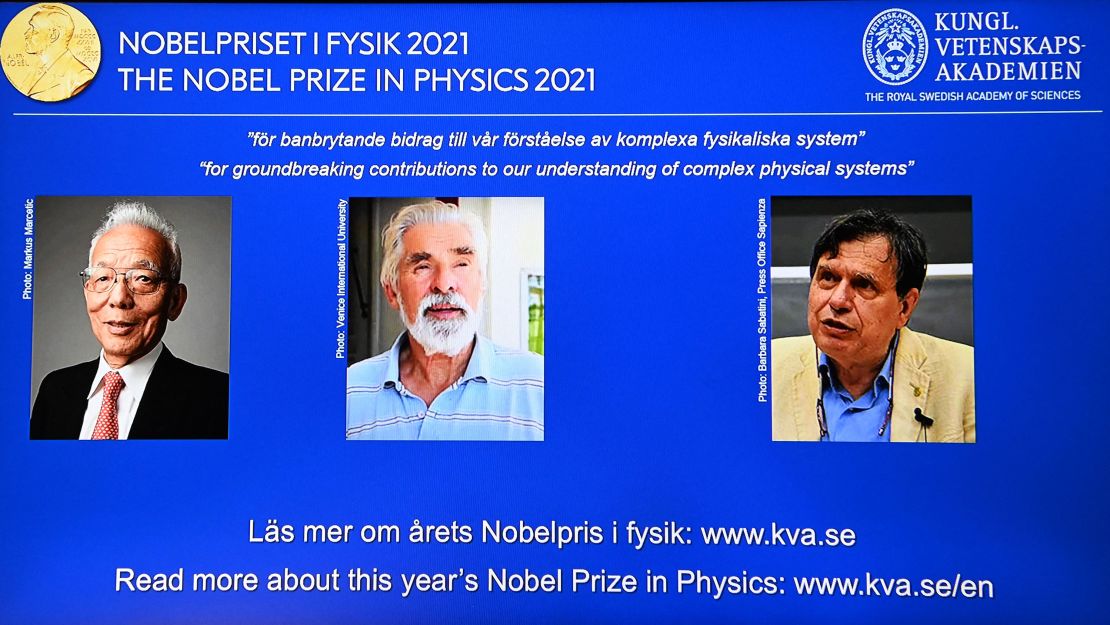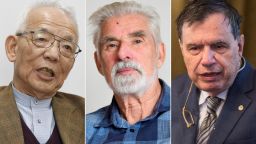The Nobel Prize in physics has been awarded to scientists Syukuro Manabe, Klaus Hasselmann and Giorgio Parisi, whose groundbreaking work over the past 60 years predicted climate change and decoded complex physical systems.
Manabe, 90, and Hasselmann, 89, were jointly honored for “the physical modelling of Earth’s climate, quantifying variability and reliably predicting global warming,” according to the news release from the Royal Swedish Academy of Sciences.
Both men carried out pioneering work in the 1960s and 1970s that sounded an early alarm on human-made climate change.
Italian physicist Parisi, 73, claimed the other half of the award, for “the discovery of the interplay of disorder and fluctuations in physical systems from atomic to planetary scales.”
The trio were announced as winners at a news conference Tuesday in Stockholm, Sweden.

Manabe’s work in the 1960s demonstrated how increased levels of carbon dioxide in the atmosphere caused the Earth’s temperature to rise. In doing so, he “laid the foundation for the development of current climate models,” the Royal Swedish Academy of Sciences said in a statement.
A decade later, Hasselmann “created a model that links together weather and climate.”
Thors-Hans Hansson, the chair of the Nobel committee, said: “It’s a physics prize. And what we are saying is that the modelling of climate is solidly based in physical theory.”
Parisi’s discoveries, meanwhile, “make it possible to understand and describe many different and apparently entirely random complex materials and phenomena.” This is not only true for physics but also for other areas, such as mathematics, biology, neuroscience and machine learning, the academy added.
The committee’s decision to recognize pioneering work on climate change comes weeks before the world’s leaders meet at COP26, a crucial summit in the United Kingdom.
Parisi, a professor at Sapienza University in Rome, acknowledged the timeliness of the award while speaking with reporters after the announcement. He said it is “urgent that we take a very strong position, and we move at a very strong pace,” adding: “It’s clear that for the future generations, we have to act now, in a very fast way.”
Michael Moloney, CEO of the American Institute of Physics, told CNN: “I can’t say whether the Nobel Prize Committee had a political message, but what it does clearly show is that [the] Earth system science models on which we understand the trajectory and the predictions for our planet’s climate [are] sound, solid science.”

“Together [the new laureates] have laid the foundation of our knowledge of the Earth’s climate and how humanity influences it, as well as revolutionized the theory of disordered materials and random processes,” added David Pendlebury, a senior citation analyst at the research company Clarivate’s Institute for Scientific Information.
First thorough calculation
Manabe, senior meteorologist at Princeton University’s Program in Atmospheric and Oceanic Sciences, harnessed the calculating power of early computers and applied it to climate. In the late 1960s, his climate circulation model was on a computer that occupied a whole room and only had half a megabyte of memory. After hundreds of hours of testing, the model showed that carbon dioxide had a clear impact – when the level of carbon dioxide doubled, global temperature increased by over 2°C.
“He was the first scientist to do a thorough calculation that was reliable,” said Gunnar Ingelman, the secretary of the Nobel physics committee. Today, nearly every climate model relies on the groundbreaking research done by Manabe, he added.
In 1980, Hasselmann, a professor at the Max Planck Institute for Meteorology in Hamburg, Germany, was able to answer the question of why climate models can be reliable despite weather being changeable and chaotic. What’s more, he developed methods for identifying impact of humankind on global temperatures.
Parisi’s work was more esoteric but no less important, said Moloney. He was was honored for his work examining the changing landscape of material states including seemingly simple things like glass.
“What Parisi’s work did was to really help us understand how at that fundamental molecular level … the qualities of systems that we see around us,” said Moloney.
What links the work of the three prize winners, he added, was that it describes the attributes of the natural world’s most tiny and fundamental constituents in order to explain large and complex phenomena.
The winners will receive 10 million Swedish kronor ($1.1 million), with one half going jointly to Manabe and Hasselmann and the other half to Parisi.
On Monday, the Nobel Prize in medicine was given to David Julius and Ardem Patapoutian for their discoveries of receptors for temperature and touch.
Sign up for CNN’s Wonder Theory science newsletter. Explore the universe with news on fascinating discoveries, scientific advancements and more.



